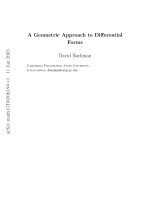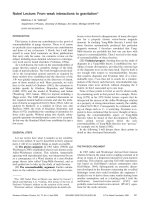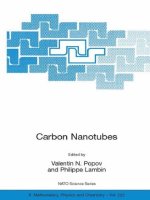- Trang chủ >>
- Khoa Học Tự Nhiên >>
- Vật lý
ALGEBRAIC LAGRANGIAN GEOMETRY FROM GEOMETRIC QUANTIZATION TO MIRROR SYMMETRY
Bạn đang xem bản rút gọn của tài liệu. Xem và tải ngay bản đầy đủ của tài liệu tại đây (146.05 KB, 5 trang )
Proc. Natl. Conf. Theor. Phys. 36 (2011), pp. 1-5
ALGEBRAIC LAGRANGIAN GEOMETRY:
FROM GEOMETRIC QUANTIZATION TO MIRROR SYMMETRY
NIKOLAY TYURIN
BLTPh JINR (Dubna) and HSE (Moscow)
ALAG — Abelian Lagrangian Algebraic Geometry, proposed by A. Tyurin
and A. Gorodentsev, [1], — is a programme indeed. As input one has (M, ω) — compact
1 - connected symplectic manifold s.t. [ω] ∈ H 2 (M, Z); as output one gets BShw,r — an
infinite dimensional Kahler manifold which is called moduli space of half weighted Bohr Sommerfeld lagrangian cycles of fixed topological type and volume.
Recall, for such a case (L, a) — prequantization data on M — are line bundle
L with hermitian connection a s.t. c1 (L) = [ω], Fa = 2πiω. Submanifold S ⊂ M is lagrangian iff ω|S ≡ 0; Bohr - Sommerfeld if a|S has trivial periods. Then the moduli
space BShw,r = {(S, θ)| S θ2 = r} where S is a Bohr - Sommerfeld (with respect to prequantization data) oriented lagrangian submanifold and θ is a half weight. The parameters
are: (integer) S has a fixed smooth type and orientation, [S] ∈ Hn (M, Z) is fixed; (real) r
- volume. Local theory — based on the Darboux - Weinstein theorem:
T(S,θ) BShw,r = C ∞ (S, R)/const ⊕ C ∞ (S, R)/const.
Moreover pairs of smooth functions (φ, ψ) give canonical coordinate system in which
Ω(S,θ) =
G(S,θ) =
S (ψ2 φ1
S (φ1 φ2
− ψ1 φ2 )θ2
+ ψ1 ψ2 )θ2
— the ingredients of canonical Kahler structure. One can prove, [2]
Existence theorem: If S ⊂ M is a smooth orientable lagrangian submanifold representing homology class [S] ∈ Hn (M, Z). Then there exists such integer k that for any level
hw,r
k > k the moduli space BS,k
is non empty.
The main aim of A. Tyurin and A. Gorodentsev: factorize BShw,r with respect to
SymM which should lead to a finite dimensional Kahler manifold. Thus it should be a
new construction of Mirror Symmetry! But dim BShw,r = dim SymM , thus one would get
just a 0-dimensional set which removes the advantage of Kahler structure.
First application of ALAG is a new method of quantization. Quantization in the
broadest context is a procedure:
(M, ω) − sympl. man.
(class. phase space)
C ∞ (M, R)
(class.observ.)
→
H − Hilbert sp.
→ (quantum phase space)
q
→
Op(H)
→
(quantum observ.)
2
NIKOLAY TYURIN
where q have to satisfy conditions from the Dirac list:
1. q(a + bf ) = aId + bq(f) (linearity),
2. q({f1 , f2 }ω ) = i[Fˆ1 , Fˆ2 ] (the correspondence principle),
3. irreducibility.
So in short: q must be an irreducible representation of the Poisson algebra.
Example: geometric quantization. If (M, ω) admits an integrable complex
structure,then
Hk = H 0 (MI , Lk )
and we have a number of methods how to construct such a map q.
On the other hand, Geometric Formulation of Quantum Mechanics, proposed
by A. Ashtekar and T. Schilling, [3], gives a vocabulry:
H, <; >
ψ∈H
ˆ
F ∈ Op(H)
→
→
→
ˆ
i[Fˆ , K]
ˆ
= −iHψ
ˆ
ψ − eigenvector H
λ − eigenvalue
projections
→
→
→
→
→
∂ψ
∂t
PH, (Ω, G, I)
p ∈ PH
∞
f ∈ Cq (P, R) ⊂ C ∞
LieXf G ≡ 0
{f, k}Ω
p˙ = Xh
p = P(ψ) − crit.point
λ − crit. value
geodesic distances
Difference between CM and QM in the presence of riemannian metric, which responds
for probabilistic aspects. It distinguishes a subspace Cq∞ (P, R) ⊂ C ∞ (P, R) — space of
symbols (in F. Berezin terminology). Ashtekar and Schilling ask are there other Kahler
manifolds which can play the role of quantum phase space? F.e., in Geometric Quantization it is the given symplectic manifold itself (with some compatible integrable complex
structure).
Geometric formulation inspires the introduction of new notion — Algebro-geometric
quantization, where one finds for a symplectic manifold (M, ω) certain Kahler (algebraic) manifold K together with a map
q : C ∞ (M, R) → Cq∞ (K, R),
respects the modified conditions from the Dirac list:
1. q(a + bf ) = a + bq(f ), ∀a, b ∈ R, f ∈ C ∞ (M, R)
2. q({f1 , f2 }ω ) = {q(f1 ), q(f2 )}Ω
3. irreducibility (= ∀p ∈ K, v ∈ Tp K there exists f ∈ C ∞ (M, R) s.t. Xq(f ) (p) = v and
ker q = 0).
If K = PH then AG - quantization ≡ quantization.
It was proved in [4], [5] that K = BShw,r is a solution of AGQ, so ALAG solves the
problem of Algebro - geometric quantization. The correspondence is given explicitly
q(f ) = Fτ (f )(S, θ) = τ
S
f |S θ2
ALGEBRAIC LAGRANGIAN GEOMETRY...
3
where τ ∈ R is a parameter. Then
1. Fτ (a + bf ) = aτ r + bFτ (f );
2. {Fτ (f1 ), Fτ (f2 )}Ω = 2τ Fτ ({f1 , f2 }ω );
3. Fτ is irreducible.
Thus the Dirac conditions are satisfied if
r = τ = 12 .
Thus one can say that every classical mechanical system, represented by (M, ω),
contains some quantum mechanical system, represented by BShw,r , and the dynamics
(classical and quantum) are compatible — and it follows the Copenhagen programme:
”... the physical predictions of a quantum theory must be formulated in terms of classical
concepts... in addition to the usual structures any sensitive quantum theory it has to admit
an appropriate passage to a classical limit ... but the correspondence between quantum
theory and classical theory has to be based not only on numerical coincidences but on an
analogy between their mathematical structures. Classical theory does approximate the
quantum theory but it does do even more - it supplies a frame to some interpretation of
the quantum theory...”
But let us come back to the background idea of A. Tyurin and A. Gorodentsev:
construct from SG- object some AG-object, namely, from a finite dimensional symplectic
manifold some finite dimensional Kahler (algebraic) manifold. This would give a new
approach in Mirror Symmetry, understood as a duality between Algebraic Geometry
and Symplectic Geometry.
Example: in Homological Mirror Symmetry (M. Kontsevich) ”duality” means that
some category derived from AG of M (the derived category of coherent sheaves) is equivalent to some category derived from SG of W (Fukaya category). But what about ”real”
geometry?
Example (A. Tyurin, C. Vafa):
Let M, W — two CY3 - manifolds,
AG(M )
|
SG(W )
m ∈ H 2∗ (M, Z)
|
w ∈ H 3 (W, Z)
realization of m
|
realization of w
by stable vect. bundles | by special lag. cycles
Mst (m)
≡
MSpLAG (w)
Problem: on the LHS there are geometrical objects and constructions indeed while on
the RHS the theory of SpLAG is still not completed yet.
Main observations for today:
1. some standard gauge theory construction can be generalized for ALAG;
2. there are some natural bundles (which we call Floer bundles) over the moduli space
BS of Bohr - Sommerfeld lagrangian cycles;
- thus one hopes that ALAG is usefull in MS.
Can we reproduce certain constructions from the Donaldson gauge theory ([6]) in
ALAG?
4
NIKOLAY TYURIN
We can construct a universal object — incidence cycle
M
p
q
← U → BS
∩
M ×
BS
U = {(x, S)} where x — point of M , S ⊂ M — Bohr - Sommerfeld cycle such that
x ∈ S. It is a problem: orientability of B, but suppose we can fix an orientation. Then
[U]P D ∈ H n (M × BS , Z) defines
µU : Hi (M, Z) → H n−i (BS , Z)
µU (σ) = [U]P D /σ
— generalized µ - classes in ALAG, analogeous to standard µ - classes in the Donaldson
theory.
Toy example: consider CP1 = S 2 with standard symplectic form. Then the moduli
space BS is given by smooth loops γ ⊂ S 2 s.t. intγ ω = outγ ω}. Cosnider minimal B. S. cycles for F. - S. metric:
BS ⊃ Mmin = {big circles}, dimR Mmin = 2
But for this case n = 1 and µU ([pt]) ∈ H 1 (BS , R).
At the same time the universal object U can be used to transport bundles and
sheaves from M to BS .For any S1 ⊂ M one has
F|S∈BS = F H(S, S1 , C)
with Floer cohomology of the pair (S, S1 ) as a fiber. But the Floer cohomology is stable
with respect to local Hamiltonian deformations therefore it is a complex bundle on BS . It’s
natural to call it Floer bundle FS1 . It depends not on S1 , but on the class of Hamiltonian
deformation of S1 . The Floer bundle FS1 carries some canonical singular connection
AS1 :
BS ⊃ B(S1 ) = {S|S transversal to S1 },
then the intersection points S ∩ S1 = {p1 , ..., pm } induce framings of F|B(S1 ) over each
small neighborhood and it gives a smooth connection over BS \B(S1 ). The singular set
Sing AS1 = BS \B(S1 ).
This connection depends strictly on the cycle S1 .
Why we are interested in vector bundles over BS ? May be it is possible to revise
the idea of A. Tyurin and A. Gorodentsev: if one finds some natural holomorphic vector
bundle E → BShw,r of finite rank k which is equivariant with respect to SymM - action
then it were k - dimensional Kahler manifold
E/SymM = W,
which could be understand as a mirror partner of the given symplectic manifold M . And
one sees that the Floer bundles are equivariant with respect to the action of Sym0 M . So
our main strategy: extend the Floer bundles in a natural way to BShw,r . We hope to reach
some result in this direction in a future.
ALGEBRAIC LAGRANGIAN GEOMETRY...
5
ACKNOWLEDGMENT
I would like to express my gratitude to the organizers of NCTP - 36 and personally
to Prof. Nguyen Hong Quang. This work is partially supported by RFBR (grant No 1101- 00980-a) and NRU - HSE (grant No 11 - 09 -0038).
REFERENCES
[1] A. Gorodentsev, A. Tyurin, “Abelian lagrangian algebraic geometry”, Izvestiya: Math 65 (2001)
437–467.
[2] N. Tyurin, “An existence theorem for the moduli space of Bohr-Sommerfeld Lagrangian cycles”,
Uspekhi Mat. Nauk 60 (2005) 179–180.
[3] A. Ashtekar, T. Schilling, “Geometric formulation of Quantum mechanics”, arXiv:gr-qc/9706069.
[4] N. Tyurin, “The correspondence principle in abelian lagrangian geometry”, Izvestiya: Math 65 (2001)
823–834.
[5] N. Tyurin, “Dynamical correspondence in algebraic lagrangian geometry”, Izvestiya: Math 66 (2002)
611–629.
[6] S. Donaldson, P. Kronheimer, The geometry of 4 - manifolds, 1990 Clarendon Press, Cambridge.
Received 30-09-2011.









